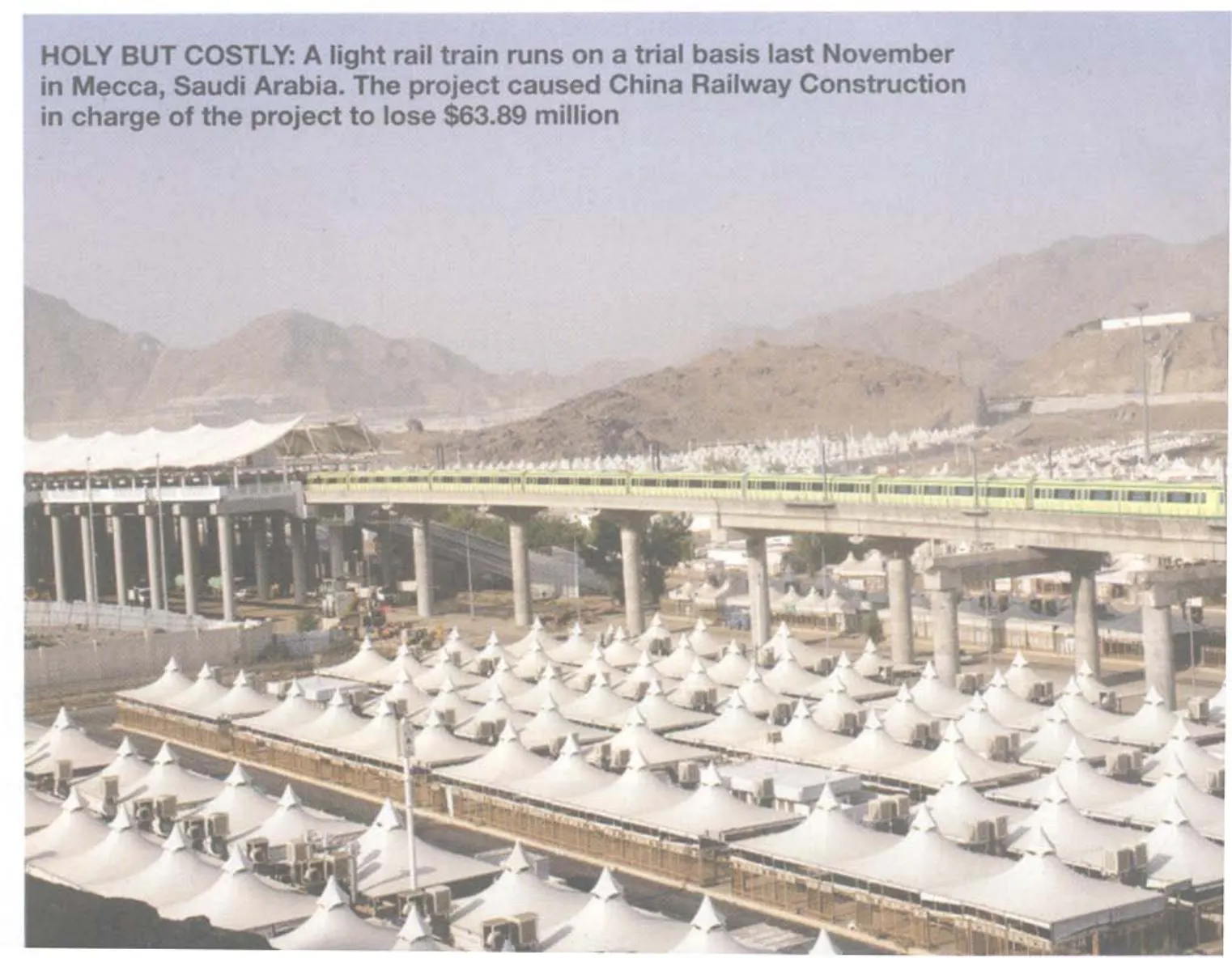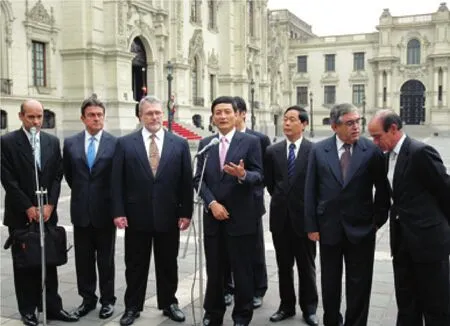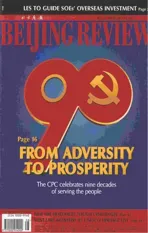An Achilles Heel
2011-10-14ByLANXINZHEN
By LAN XINZHEN
An Achilles Heel
By LAN XINZHEN
State regulator tightens supervision over state overseas assets
The regulator of China’s state-owned assets on June 27 announced new measures to supervise overseas assets of centrally administered state-owned enterprises (SOEs) amid what the State-Owned Assets Supervision and Administration Commission (SASAC)called “increasing complexities.”
The newly announced pair of regulations aim to stop management loopholes and improve the safety of SOEs’ overseas assets.
The Interim Regulations on the Supervision and Administration of Overseas Assets of Central SOEs concern central SOEs’ overseas investment, management and various operating activities,both internal and external. The Interim Regulations on the Administration of Overseas Property Rights of SOEs regulate registration, assessment, examination and transmission of the overseas properties of central SOEs and set out requirements for the equity management of red-chip companies, mainland-based companies that are incorporated internationally and listed on the Hong Kong Stock Exchange.
The release of the two interim provisions is an important measure for SASAC to ful fi ll its responsibility as state-owned assets owner, complete the accountability mechanism for preserving and increasing the value of state-owned assets and enhance the management of SOEs’ overseas assets, SASAC said.It is conducive to helping China’s SOEs foster world-class competitive enterprises and accelerating the internationalization of their management strategies.
SASAC’s new regulatory measures standardize individual equity holdings on behalf of SOEs, which used to lead to losses of assets overseas. Any transaction of equity holding that would change the holding status of SOEs must get the approval from SASAC, said the interim regulation. Those responsible for the loss of overseas assets and mismanagement will be held accountable by the SASAC in accordance with relevant laws and regulations on state-owned assets management.
Costly lessons
Since China entered the WTO in 2001,its SOEs have been the major pioneering force in overseas investment. The global fi nancial crisis in 2008 has been the catalyst for the move. Official figures show 100 out of 120 central SOEs have established overseas branches or administrative organizations. The overseas assets of SOEs amounted to 4 trillion yuan ($610 billion) at the end of 2010, accounting for 20 percent of their total assets.
Ironically, while Chinese SOEs were obsessed with outbound investment mania, their regulators seemed to be stood idle. The fact is the latest regulations on overseas state-owned assets could be dated back to 1999. China established the SASAC particularly for the supervision and management of SOEs, but it still failed to fulfill the responsibility of monitoring the overseas operation of SOEs as evidenced by a series of losses in overseas investment in recent years.
China Aviation Oil (Singapore) lost about$550 million from ill-placed bets on oil prices in 2004. The Chief Executive Chen Jiulin was sentenced to 1,035 days in prison. This year China Railway Construction reported a loss of 4.153 billion yuan ($63.89 million) from its light railway project in Saudi Arabia.
The war in Libya has affected 50 projects undertaken by 75 Chinese enterprises involving $18.8 billion, said the Ministry of Commerce.
A report released by the National Audit Of fi ce this May said Sinochem Group, China’s biggest chemical trader, lost $15.27 million in its three overseas oil gas projects and another two did not produce pro fi ts as high as expected.
While Chinese SOEs witness a dramatically growing outbound investment, the risks are also increasing, said Wang Yong,SASAC Minister.
Wang also summarized the reasons for the investment failure of SOEs. Some did not choose the right projects to invest in as the projects have too little correlation with their main business; some advanced their outbound expansion too fast, exceeding their own capital, management and talent capability; some lacked strict and complete regulations and rules on overseas investment; some were weak in risk management and in the ability to control risks;and some even entangled with mutual competitions.
The management of overseas assets was slack with insuf fi cient risk-control measures among SOEs, compared to their emphasis on overseas investments, Wang said.
With the acceleration of their going global, SOEs must enhance their risk control,he said.
A timely decision
SASAC did, however, acknowledge the positive side of SOEs’ overseas investment.
“In recent years, SOEs have seen a rapid growth in their overseas business scale and expansion in overseas business fi elds. Some SOEs have created lots of successful experiences in supervising overseas assets,” said SASAC.
SASAC also acknowledged its weakness in supervising overseas state-owned property. “Some SOEs slack off when it comes to internal management and risk control, which may affect the security of overseas stateowned assets,” it said.
In a bid to further strengthen supervision and protection on SOEs’ overseas assets, the SASAC released the two interim regulations which were enacted with full consideration of the lessons and experiences SOEs have learnt from their outbound investment in recent years, SASAC said.
The oversight organization also gave the legal basis of the two regulations, namely,the Law on State-Owned Assets and the Interim Regulations on Supervision of State-Owned Assets released in 2003.
The two interim regulations were innovative in supervising state-owned assets and property rights. The Interim Regulations on the Supervision and Administration of Overseas Assets of Central SOEs have set out detailed rules to regulate behavior that may easily cause losses of overseas investment, for example, the individual equity holding, offshore company management and salary of expatriate staff.
Despite the fact Chinese centrally administered SOEs have increasing outbound investment, they still lack systematic management measures to supervise overseas assets, said Zhang Hanlin, Director of the Center for WTO Studies at the University of International Business and Economics.
Due to the lack of a complete supervision mechanism, SOEs and their regulators often failed to see risks in overseas investment, especially in the fi eld of fi nancial investment,Zhang said.
The best way to regulate SOEs’ overseas investment, shield investment risks and prevent losses of state-owned assets is to enhance legislation timely, Zhang said.
The release of the two interim regulations is the inevitable result of the country’s efforts to enhance supervision on overseas investment, Zhang said.
Risk management
Facing huge losses in overseas investment, it is time for SOEs to ful fi ll their own responsibilities.
SASAC has issued two preventive regulations, but the SOEs themselves need to enhance risk management in their overseas operation, said He Liping, a professor with the School of Economics and Business Administration of Beijing Normal University.
A standard administrative structure and complete internal management mechanism are needed to enhance risk control, especially for overseas investment of SOEs, He said.
Wang Ying, an analyst with the Shanghai-based CBN Research Institute,echoed He’s idea.
“At present, the domestic parent SOEs should be responsible for the supervision on overseas assets and properties. A daily mechanism to control risk should be set up and the decision-making procedure should be regulated,” Wang said.
“Even though the SASAC has stipulated detailed rules, only the SOEs themselves can achieve their investment goals and risk control. The new regulations are just macrolevel guidance,” Wang added.
SOEs should look to protection of their overseas investment, said Wang Hai, an analyst with China Securities Co. Ltd.
If the host countries refuse to compensate the asset loss in exchange rates, nationalization and political turmoil, Chinese SOEs could claim losses to the insurance issuers, he said.
China should learn from the success of the United States and Japan in insurance for overseas investment and promote the launching of relevant insurance measures in China,he said.

(Left) HOLY BUT COSTLY:A light rail train runs on a trial basis last November in Mecca, Saudi Arabia.The project caused China Railway Construction in charge of the project to lose $63.89 million

LIU GUOQIANG
COPPER COOPERATION:Xiao Yaqing (center),former Chinalco CEO,answers questions during a news conference held at the presidential office in Lima, Peru, on May 5,2008, after Chinalco and Peru Copper Inc. signed an exercise contract for the Toromocho copper project
